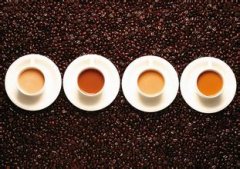Description of Flavor of Yunnan small-grain Coffee
Description of Flavor of Yunnan small-grain Coffee
According to the determination of experts, small seed coffee should be planted in the mountains at an altitude of 800 to 1800 meters. If the altitude is too high, it will taste sour, and if it is too low, it will taste bitter. Yunnan coffee is mostly planted in dry and hot valleys at an altitude of 1100 meters above sea level, so it has a moderate sour taste, rich and mellow aroma. In terms of climatic conditions, the long light time in southern Yunnan is conducive to plant growth and photosynthesis, and the large temperature difference between day and night and low temperature at night are conducive to the accumulation of coffee nutrients. Therefore, the effective nutrients of Yunnan small-grain coffee are higher than those of other foreign coffee varieties. Small seed coffee is easy to be infected with rust, and the yield and quality of embroidery disease are deeply affected. In the hot area of Yunnan, due to the distinct dry and wet, the red ripening of fresh fruit enters the dry season every year, and the relative humidity is low, which is not conducive to the formation and growth of rust blister. Due to the excellent quality of Yunnan coffee, it entered the London market with "Lujiang No.1" in the 1960s and was rated as first-class. In recent years, the world-famous coffee companies such as Nestle and McDonnell have come to Yunnan to open up raw material bases, and the products produced in Yunnan are also gradually famous at home and abroad. At present, the average yield of coffee in Yunnan has reached 96.4 kg, and a household contracted land in Lujiang has set a world record of 400 kg. "I have seen countless coffee plantations in the world, where the management is world-class and the yield is the highest," said Steyhead, a chief coffee expert at the United Nations Planning and Development Program, after visiting the coffee garden at Lujiang Farm. "
Coffee is different from tea, do not use freshly boiled water to make coffee! The water for brewing coffee should not be higher than 96 °, nor should it be too low. If the water is boiled a little, cool for 2 minutes before brewing coffee, and do not use warm water that has been kept for a long time, it is best to start with cold water and heat to the right temperature and then go to make coffee. And brewing coffee with high-temperature water above 90 °will bring out a strong bitter taste, while a low water temperature will make the sour taste appear. In addition, the injection of hot water is slow, the bitter taste will be strong, on the contrary, it will be sour. For the bottled water on the market, you will hear that there are "soft" and "hard". The so-called "soft" and "hard" refers to the total concentration of calcium and magnesium ions in the water. The low concentration is soft water, but it is hard water anyway. But soft water and hard water does not mean which kind of water is good for brewing coffee, but which kind of brewed coffee is more in line with your preference. Soft water taste clean and refreshing, brewed coffee taste smooth, easy to show the sour taste of coffee and its own characteristics; hard water will cause coffee bitter taste, taste irritation, roasted aroma will also be obvious.
For example, the well-known Evian, which is taken from the water source of Cachat in the small town of Evian near Lake Geneva in the foothills of Mount Blanc, is world-famous medium-hard water. The forest water in Japan is an assembled soft water which absorbs the natural water nurtured by nature from various water sources in Japan and is directly sealed on the spot.

Important Notice :
前街咖啡 FrontStreet Coffee has moved to new addredd:
FrontStreet Coffee Address: 315,Donghua East Road,GuangZhou
Tel:020 38364473
- Prev

Introduction to the Grinding scale for the description of Taste and Flavor of Brazilian Coffee
Brazil makes full use of the tropical geographical environment and attaches importance to the production and sale of coffee, so that the output, export volume and per capita consumption of coffee have been ranked first in the world for many years, and have been praised as the coffee kingdom. Coffee was introduced into Brazil after the 18th century. In 1727, coffee was introduced from Guyana to Belem, Brazil.
- Next

Flavor description of Columbia narino Coffee Bean introduction to the production area of Grinding scale varieties
Description of the flavor of Colombian narino coffee beans the varieties of Colombian coffee are mainly small-grain coffee. Plants are small trees or large shrubs, 5-8 m tall, usually much branched at base; old branches gray-white, nodes dilated, young branches glabrous, compressed. Leaves thinly leathery, ovate-lanceolate or lanceolate, 6-14 cm long, 3.5-5 cm wide, tip long acuminate
Related
- Detailed explanation of Jadeite planting Land in Panamanian Jadeite Manor introduction to the grading system of Jadeite competitive bidding, Red bid, Green bid and Rose Summer
- Story of Coffee planting in Brenka region of Costa Rica Stonehenge Manor anaerobic heavy honey treatment of flavor mouth
- What's on the barrel of Blue Mountain Coffee beans?
- Can American coffee also pull flowers? How to use hot American style to pull out a good-looking pattern?
- Can you make a cold extract with coffee beans? What is the right proportion for cold-extracted coffee formula?
- Indonesian PWN Gold Mandrine Coffee Origin Features Flavor How to Chong? Mandolin coffee is American.
- A brief introduction to the flavor characteristics of Brazilian yellow bourbon coffee beans
- What is the effect of different water quality on the flavor of cold-extracted coffee? What kind of water is best for brewing coffee?
- Why do you think of Rose Summer whenever you mention Panamanian coffee?
- Introduction to the characteristics of authentic blue mountain coffee bean producing areas? What is the CIB Coffee Authority in Jamaica?

